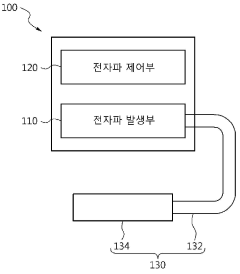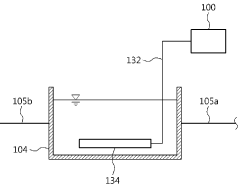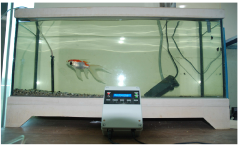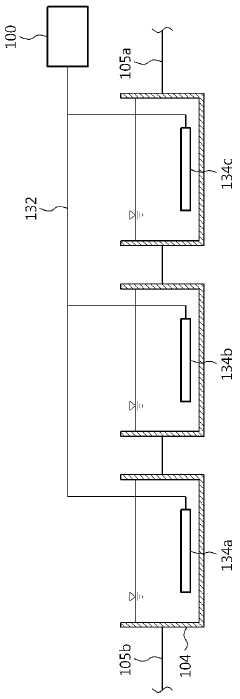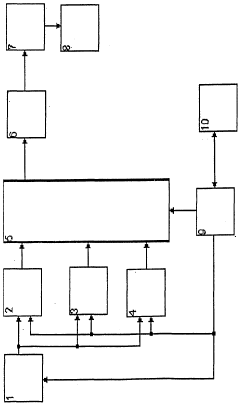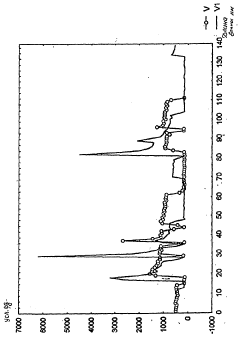Electromagnetic Waves and Their Contribution to Clean Water Technologies
JUL 11, 202510 MIN READ
Generate Your Research Report Instantly with AI Agent
Patsnap Eureka helps you evaluate technical feasibility & market potential.
EM Waves in Water Treatment: Background and Objectives
Electromagnetic waves have emerged as a promising technology in the field of water treatment, offering innovative solutions to address the global challenge of clean water scarcity. The background of this technology dates back to the early 20th century when scientists began exploring the interactions between electromagnetic fields and various materials, including water. Over the decades, research has progressively uncovered the potential of electromagnetic waves in modifying water properties and removing contaminants.
The evolution of electromagnetic wave technology in water treatment has been driven by the increasing demand for efficient, cost-effective, and environmentally friendly water purification methods. Traditional water treatment techniques, such as chemical disinfection and membrane filtration, while effective, often come with limitations such as high energy consumption, chemical residues, and maintenance costs. Electromagnetic wave technology offers a promising alternative that addresses many of these challenges.
The primary objective of research in this field is to harness the unique properties of electromagnetic waves to enhance water treatment processes. This includes investigating various frequencies and intensities of electromagnetic waves and their effects on different types of water contaminants. Researchers aim to develop systems that can effectively remove pollutants, including microorganisms, heavy metals, and organic compounds, while minimizing energy consumption and environmental impact.
One of the key goals is to understand the fundamental mechanisms by which electromagnetic waves interact with water molecules and contaminants. This involves studying phenomena such as molecular vibration, ionization, and the breaking of chemical bonds. By gaining a deeper understanding of these processes, scientists can optimize the application of electromagnetic waves for specific water treatment scenarios.
Another important objective is to scale up laboratory findings to practical, industrial-scale applications. This involves addressing challenges related to system design, energy efficiency, and integration with existing water treatment infrastructure. Researchers are working on developing robust, reliable, and cost-effective electromagnetic wave systems that can be deployed in various settings, from small-scale household units to large municipal water treatment plants.
The technology also aims to contribute to sustainable development goals by providing access to clean water in remote and underdeveloped areas. Portable and low-maintenance electromagnetic wave devices could potentially offer a solution for communities lacking access to traditional water treatment facilities. This aligns with the broader objective of improving global health and reducing waterborne diseases through innovative water purification technologies.
As research in this field progresses, there is a growing focus on combining electromagnetic wave technology with other advanced water treatment methods, such as nanotechnology and advanced oxidation processes. This interdisciplinary approach seeks to create synergistic effects, further enhancing the efficiency and effectiveness of water treatment systems.
The evolution of electromagnetic wave technology in water treatment has been driven by the increasing demand for efficient, cost-effective, and environmentally friendly water purification methods. Traditional water treatment techniques, such as chemical disinfection and membrane filtration, while effective, often come with limitations such as high energy consumption, chemical residues, and maintenance costs. Electromagnetic wave technology offers a promising alternative that addresses many of these challenges.
The primary objective of research in this field is to harness the unique properties of electromagnetic waves to enhance water treatment processes. This includes investigating various frequencies and intensities of electromagnetic waves and their effects on different types of water contaminants. Researchers aim to develop systems that can effectively remove pollutants, including microorganisms, heavy metals, and organic compounds, while minimizing energy consumption and environmental impact.
One of the key goals is to understand the fundamental mechanisms by which electromagnetic waves interact with water molecules and contaminants. This involves studying phenomena such as molecular vibration, ionization, and the breaking of chemical bonds. By gaining a deeper understanding of these processes, scientists can optimize the application of electromagnetic waves for specific water treatment scenarios.
Another important objective is to scale up laboratory findings to practical, industrial-scale applications. This involves addressing challenges related to system design, energy efficiency, and integration with existing water treatment infrastructure. Researchers are working on developing robust, reliable, and cost-effective electromagnetic wave systems that can be deployed in various settings, from small-scale household units to large municipal water treatment plants.
The technology also aims to contribute to sustainable development goals by providing access to clean water in remote and underdeveloped areas. Portable and low-maintenance electromagnetic wave devices could potentially offer a solution for communities lacking access to traditional water treatment facilities. This aligns with the broader objective of improving global health and reducing waterborne diseases through innovative water purification technologies.
As research in this field progresses, there is a growing focus on combining electromagnetic wave technology with other advanced water treatment methods, such as nanotechnology and advanced oxidation processes. This interdisciplinary approach seeks to create synergistic effects, further enhancing the efficiency and effectiveness of water treatment systems.
Market Analysis for EM-based Water Purification
The market for electromagnetic (EM) wave-based water purification technologies has shown significant growth potential in recent years, driven by increasing global water scarcity and the need for efficient, sustainable water treatment solutions. This market segment is positioned at the intersection of environmental technology and water management, addressing critical challenges in both developed and developing regions.
The global water purification market, which includes EM-based technologies, was valued at approximately $30 billion in 2020 and is projected to reach $45 billion by 2025, with a compound annual growth rate (CAGR) of 8.5%. Within this broader market, EM-based water purification technologies are gaining traction due to their unique advantages in treating various water contaminants.
Key factors driving market demand include the rising population, urbanization, and industrialization, which have led to increased water pollution and the need for advanced treatment methods. Additionally, stringent water quality regulations in many countries have spurred the adoption of innovative purification technologies. The COVID-19 pandemic has further heightened awareness of the importance of clean water, potentially accelerating market growth.
Geographically, North America and Europe currently dominate the market for EM-based water purification technologies, owing to their advanced infrastructure and higher investment in research and development. However, the Asia-Pacific region is expected to witness the fastest growth, driven by rapid industrialization, population growth, and increasing water stress in countries like China and India.
The industrial sector represents the largest market segment for EM-based water purification, particularly in applications such as wastewater treatment in manufacturing, oil and gas, and mining industries. The municipal water treatment sector is also a significant market, with growing adoption in both urban and rural areas for drinking water purification and sewage treatment.
Emerging trends in the market include the integration of EM technologies with other advanced treatment methods, such as membrane filtration and UV disinfection, to create more comprehensive and efficient water purification systems. There is also a growing focus on developing compact, energy-efficient EM-based systems for point-of-use applications in households and small communities.
Challenges in market growth include the high initial investment costs associated with EM-based systems and the need for specialized expertise in operation and maintenance. However, ongoing research and development efforts are expected to address these issues, potentially leading to more cost-effective and user-friendly solutions in the future.
The global water purification market, which includes EM-based technologies, was valued at approximately $30 billion in 2020 and is projected to reach $45 billion by 2025, with a compound annual growth rate (CAGR) of 8.5%. Within this broader market, EM-based water purification technologies are gaining traction due to their unique advantages in treating various water contaminants.
Key factors driving market demand include the rising population, urbanization, and industrialization, which have led to increased water pollution and the need for advanced treatment methods. Additionally, stringent water quality regulations in many countries have spurred the adoption of innovative purification technologies. The COVID-19 pandemic has further heightened awareness of the importance of clean water, potentially accelerating market growth.
Geographically, North America and Europe currently dominate the market for EM-based water purification technologies, owing to their advanced infrastructure and higher investment in research and development. However, the Asia-Pacific region is expected to witness the fastest growth, driven by rapid industrialization, population growth, and increasing water stress in countries like China and India.
The industrial sector represents the largest market segment for EM-based water purification, particularly in applications such as wastewater treatment in manufacturing, oil and gas, and mining industries. The municipal water treatment sector is also a significant market, with growing adoption in both urban and rural areas for drinking water purification and sewage treatment.
Emerging trends in the market include the integration of EM technologies with other advanced treatment methods, such as membrane filtration and UV disinfection, to create more comprehensive and efficient water purification systems. There is also a growing focus on developing compact, energy-efficient EM-based systems for point-of-use applications in households and small communities.
Challenges in market growth include the high initial investment costs associated with EM-based systems and the need for specialized expertise in operation and maintenance. However, ongoing research and development efforts are expected to address these issues, potentially leading to more cost-effective and user-friendly solutions in the future.
Current Challenges in EM Water Treatment
Electromagnetic (EM) water treatment technologies face several significant challenges that hinder their widespread adoption and effectiveness in addressing global water scarcity and contamination issues. One of the primary obstacles is the high energy consumption associated with these systems. The generation and maintenance of electromagnetic fields require substantial power input, which can lead to increased operational costs and reduced sustainability, particularly in regions with limited access to reliable energy sources.
Another critical challenge is the variability in treatment efficiency across different types of contaminants. While EM technologies have shown promise in removing certain pollutants, their effectiveness can be inconsistent when dealing with complex mixtures of contaminants commonly found in real-world water sources. This variability makes it difficult to develop standardized treatment protocols and predict outcomes in diverse environmental conditions.
The scalability of EM water treatment systems presents another significant hurdle. Many current technologies demonstrate efficacy at laboratory or small-scale levels but face difficulties when scaled up for industrial or municipal applications. This scaling issue is often related to the need for precise control of electromagnetic field parameters over larger volumes of water, which becomes increasingly challenging as system size increases.
Furthermore, the long-term effects of EM treatment on water quality and ecosystem health remain a concern. While short-term studies have shown promising results, there is a lack of comprehensive long-term data on the potential impacts of treated water on human health and the environment. This knowledge gap creates uncertainty and hesitation among policymakers and water management authorities in adopting these technologies on a large scale.
The complexity of EM water treatment systems also poses challenges in terms of maintenance and operation. These systems often require specialized knowledge and skills to operate effectively, which may not be readily available in all regions, particularly in developing countries where water treatment needs are often most pressing.
Additionally, there are regulatory and public perception challenges to overcome. The use of electromagnetic fields in water treatment is a relatively new approach, and regulatory frameworks in many countries have not yet fully adapted to assess and approve these technologies. This regulatory uncertainty, coupled with public skepticism about the safety and efficacy of EM treatment, can slow down the adoption and implementation of these innovative solutions.
Lastly, the cost-effectiveness of EM water treatment technologies compared to conventional methods remains a significant challenge. While these technologies offer potential advantages in terms of treatment efficiency and environmental impact, the initial investment and operational costs can be higher than traditional water treatment methods. This economic barrier can deter adoption, especially in resource-constrained environments where immediate cost considerations often outweigh long-term benefits.
Another critical challenge is the variability in treatment efficiency across different types of contaminants. While EM technologies have shown promise in removing certain pollutants, their effectiveness can be inconsistent when dealing with complex mixtures of contaminants commonly found in real-world water sources. This variability makes it difficult to develop standardized treatment protocols and predict outcomes in diverse environmental conditions.
The scalability of EM water treatment systems presents another significant hurdle. Many current technologies demonstrate efficacy at laboratory or small-scale levels but face difficulties when scaled up for industrial or municipal applications. This scaling issue is often related to the need for precise control of electromagnetic field parameters over larger volumes of water, which becomes increasingly challenging as system size increases.
Furthermore, the long-term effects of EM treatment on water quality and ecosystem health remain a concern. While short-term studies have shown promising results, there is a lack of comprehensive long-term data on the potential impacts of treated water on human health and the environment. This knowledge gap creates uncertainty and hesitation among policymakers and water management authorities in adopting these technologies on a large scale.
The complexity of EM water treatment systems also poses challenges in terms of maintenance and operation. These systems often require specialized knowledge and skills to operate effectively, which may not be readily available in all regions, particularly in developing countries where water treatment needs are often most pressing.
Additionally, there are regulatory and public perception challenges to overcome. The use of electromagnetic fields in water treatment is a relatively new approach, and regulatory frameworks in many countries have not yet fully adapted to assess and approve these technologies. This regulatory uncertainty, coupled with public skepticism about the safety and efficacy of EM treatment, can slow down the adoption and implementation of these innovative solutions.
Lastly, the cost-effectiveness of EM water treatment technologies compared to conventional methods remains a significant challenge. While these technologies offer potential advantages in terms of treatment efficiency and environmental impact, the initial investment and operational costs can be higher than traditional water treatment methods. This economic barrier can deter adoption, especially in resource-constrained environments where immediate cost considerations often outweigh long-term benefits.
Existing EM-based Water Cleaning Solutions
01 Electromagnetic wave-based water purification systems
These systems use electromagnetic waves to purify water by destroying or inactivating harmful microorganisms and contaminants. The technology can be applied in various water treatment applications, offering an efficient and chemical-free method for water purification.- Electromagnetic wave-based water purification systems: These systems use electromagnetic waves to purify water by destroying or inactivating harmful microorganisms and contaminants. The technology can be applied in various water treatment applications, offering an efficient and chemical-free method for water purification.
- Ultraviolet (UV) radiation for water disinfection: UV radiation, a type of electromagnetic wave, is used to disinfect water by damaging the DNA of microorganisms, rendering them unable to reproduce. This method is effective against a wide range of pathogens and can be integrated into various water treatment systems.
- Electromagnetic field-induced water treatment: This approach involves applying electromagnetic fields to water, which can alter its properties and potentially remove contaminants. The technology may be used for scale prevention, water softening, and enhancing the efficiency of other treatment processes.
- Combination of electromagnetic waves with other purification methods: Integrating electromagnetic wave-based purification with other treatment technologies, such as filtration or chemical treatment, can enhance overall water purification efficiency. This combined approach may address a broader range of contaminants and improve water quality.
- Electromagnetic wave generators for water treatment: Specialized devices designed to generate specific electromagnetic waves for water purification purposes. These generators can be optimized for different water treatment applications and integrated into various water purification systems.
02 Ultraviolet (UV) radiation for water disinfection
UV radiation, a type of electromagnetic wave, is used to disinfect water by damaging the DNA of microorganisms, rendering them unable to reproduce. This method is effective against a wide range of pathogens and can be integrated into various water treatment systems.Expand Specific Solutions03 Electromagnetic field generation for water treatment
This approach involves generating electromagnetic fields to treat water, which can help in removing contaminants, reducing scale formation, and improving overall water quality. The technology can be applied in both industrial and residential settings.Expand Specific Solutions04 Combination of electromagnetic waves with other purification methods
This approach combines electromagnetic wave treatment with other water purification techniques such as filtration, oxidation, or adsorption. The synergistic effect can lead to more efficient and comprehensive water treatment processes.Expand Specific Solutions05 Electromagnetic wave-based sensors for water quality monitoring
These sensors use electromagnetic waves to detect and monitor various water quality parameters, such as contaminant levels, pH, and dissolved oxygen. This technology enables real-time monitoring and control of water purification processes, ensuring optimal treatment efficiency.Expand Specific Solutions
Key Players in EM Water Treatment Industry
The research on electromagnetic waves and their contribution to clean water technologies is in a nascent stage, with the market showing significant growth potential. The global water treatment technology market is expanding rapidly, driven by increasing water scarcity and pollution concerns. Companies like Canon, Xiamen Nuodi Membrane Technology, and Water Waves B.V. are at the forefront of developing innovative solutions. While the technology is still evolving, it demonstrates promising applications in water purification and treatment processes. The involvement of diverse players, including established corporations, specialized startups, and academic institutions like The Hong Kong University of Science & Technology, indicates a competitive and collaborative landscape, fostering rapid advancements in this critical field.
Xiamen Nuodi Membrane Technology Co., Ltd.
Technical Solution: Xiamen Nuodi Membrane Technology specializes in advanced membrane filtration systems for water purification. Their technology utilizes electromagnetic waves to enhance membrane performance and reduce fouling. The company has developed a novel electromagnetic anti-fouling membrane (EAM) that employs a low-frequency electromagnetic field to create a dynamic, oscillating water layer near the membrane surface[4]. This oscillation helps prevent the accumulation of foulants and improves overall filtration efficiency. Nuodi's EAM technology has been shown to increase flux rates by up to 30% compared to conventional membranes while significantly reducing cleaning frequency and extending membrane lifespan[5].
Strengths: Improved membrane performance, reduced operational costs, extended membrane life. Weaknesses: May require additional energy input for electromagnetic field generation, potential limitations in high-salinity environments.
Planet Horizons Technologies SA
Technical Solution: Planet Horizons Technologies has developed a unique water treatment system called Aqua4D, which uses low-frequency electromagnetic waves to modify the physical properties of water and dissolved minerals. Their technology aims to improve water quality and efficiency in agriculture and building management. The Aqua4D system generates a specific electromagnetic field that alters the clustering behavior of water molecules and affects the crystallization of dissolved minerals[6]. This process can help prevent scale formation in pipes and irrigation systems, improve soil permeability, and enhance nutrient uptake in plants. The company claims their technology can reduce water consumption by up to 30% in agricultural applications while improving crop yields[7].
Strengths: Non-chemical approach, potential for significant water savings, applicable to both agriculture and building management. Weaknesses: Efficacy may vary depending on water composition and environmental factors, limited peer-reviewed studies on long-term effects.
Core Innovations in EM Water Purification
Water purifying apparatus using multi wavelengths
PatentInactiveKR1020150054116A
Innovation
- A water quality improvement device utilizing electromagnetic waves with multiple wavelengths to achieve sterilization and insecticidal effects through constructive or destructive interference, enhancing sterilization efficiency and reducing bacterial growth.
Device for cleaning water solutions
PatentWO2002096809A1
Innovation
- A water purification device employing a laser with a control system generating electromagnetic radiation across multiple frequency ranges, combined with sound and ultrasonic waves, to enhance the destruction of organic substances and microorganisms through cavitation and oxidation processes.
Environmental Impact of EM Water Technologies
The implementation of electromagnetic (EM) water technologies has significant environmental implications, both positive and negative. On the positive side, these technologies offer a promising alternative to traditional water treatment methods, potentially reducing the reliance on chemical additives and energy-intensive processes. EM-based water treatment systems can effectively remove contaminants, including microorganisms, heavy metals, and organic pollutants, without introducing harmful byproducts into the environment.
One of the key environmental benefits of EM water technologies is their potential to reduce the carbon footprint associated with water treatment. Compared to conventional methods, EM-based systems often require less energy and fewer chemical inputs, leading to lower greenhouse gas emissions and reduced chemical waste. This aligns with global efforts to mitigate climate change and promote sustainable resource management.
Furthermore, EM water technologies can contribute to the conservation of water resources. By improving the efficiency of water treatment processes, these technologies enable the reclamation and reuse of wastewater, reducing the pressure on freshwater sources. This is particularly crucial in water-scarce regions, where sustainable water management is essential for environmental preservation and economic development.
However, the environmental impact of EM water technologies is not without concerns. The generation of electromagnetic fields during the treatment process may have potential effects on local ecosystems, particularly aquatic life. While research in this area is ongoing, some studies suggest that prolonged exposure to electromagnetic fields could affect the behavior and physiology of certain organisms.
Another consideration is the lifecycle impact of EM water treatment equipment. The production, installation, and eventual disposal of these systems involve resource consumption and potential environmental risks. Ensuring the responsible manufacture, use, and end-of-life management of EM water treatment technologies is crucial to maximizing their net positive environmental impact.
Additionally, the widespread adoption of EM water technologies may lead to changes in water management practices and infrastructure. While this could result in more efficient and environmentally friendly water systems overall, the transition period may involve temporary disruptions and resource allocation challenges that need to be carefully managed to minimize negative environmental consequences.
In conclusion, the environmental impact of EM water technologies is multifaceted, offering significant potential benefits in terms of reduced chemical usage, energy consumption, and water conservation. However, careful consideration must be given to potential ecosystem effects, lifecycle impacts, and the broader implications for water management systems to ensure that the implementation of these technologies results in a net positive environmental outcome.
One of the key environmental benefits of EM water technologies is their potential to reduce the carbon footprint associated with water treatment. Compared to conventional methods, EM-based systems often require less energy and fewer chemical inputs, leading to lower greenhouse gas emissions and reduced chemical waste. This aligns with global efforts to mitigate climate change and promote sustainable resource management.
Furthermore, EM water technologies can contribute to the conservation of water resources. By improving the efficiency of water treatment processes, these technologies enable the reclamation and reuse of wastewater, reducing the pressure on freshwater sources. This is particularly crucial in water-scarce regions, where sustainable water management is essential for environmental preservation and economic development.
However, the environmental impact of EM water technologies is not without concerns. The generation of electromagnetic fields during the treatment process may have potential effects on local ecosystems, particularly aquatic life. While research in this area is ongoing, some studies suggest that prolonged exposure to electromagnetic fields could affect the behavior and physiology of certain organisms.
Another consideration is the lifecycle impact of EM water treatment equipment. The production, installation, and eventual disposal of these systems involve resource consumption and potential environmental risks. Ensuring the responsible manufacture, use, and end-of-life management of EM water treatment technologies is crucial to maximizing their net positive environmental impact.
Additionally, the widespread adoption of EM water technologies may lead to changes in water management practices and infrastructure. While this could result in more efficient and environmentally friendly water systems overall, the transition period may involve temporary disruptions and resource allocation challenges that need to be carefully managed to minimize negative environmental consequences.
In conclusion, the environmental impact of EM water technologies is multifaceted, offering significant potential benefits in terms of reduced chemical usage, energy consumption, and water conservation. However, careful consideration must be given to potential ecosystem effects, lifecycle impacts, and the broader implications for water management systems to ensure that the implementation of these technologies results in a net positive environmental outcome.
Regulatory Framework for EM Water Treatment
The regulatory framework for electromagnetic (EM) water treatment technologies is a complex and evolving landscape that varies across different jurisdictions. In the United States, the Environmental Protection Agency (EPA) plays a crucial role in overseeing and regulating water treatment technologies, including those utilizing electromagnetic waves. The Safe Drinking Water Act (SDWA) provides the primary legal basis for ensuring the safety of drinking water and sets standards for various contaminants.
For EM water treatment technologies to be approved for use in public water systems, they must demonstrate compliance with the EPA's stringent requirements. This typically involves extensive testing and validation to prove the technology's efficacy in removing contaminants and its overall safety. The EPA's Environmental Technology Verification (ETV) program, although no longer active, has provided a framework for evaluating innovative environmental technologies, including water treatment methods.
In the European Union, the regulatory landscape is governed by the Drinking Water Directive (DWD), which sets quality standards for drinking water. The European Food Safety Authority (EFSA) also plays a role in assessing the safety of materials and technologies used in water treatment. EM water treatment technologies must adhere to these standards and undergo rigorous evaluation before being approved for use in EU member states.
Internationally, the World Health Organization (WHO) provides guidelines for drinking water quality, which many countries use as a basis for their national regulations. These guidelines address various aspects of water treatment, including the use of novel technologies like EM-based systems.
As EM water treatment technologies continue to evolve, regulatory bodies are adapting their frameworks to accommodate these innovations. This includes developing new testing protocols and safety assessments specific to EM-based systems. For instance, the potential long-term effects of electromagnetic exposure on water quality and human health are areas of ongoing research and regulatory consideration.
Regulatory compliance also extends to the manufacturing and operational aspects of EM water treatment systems. This includes adherence to electromagnetic compatibility (EMC) standards to ensure that these systems do not interfere with other electronic equipment or pose electromagnetic hazards. In many jurisdictions, EM water treatment devices must obtain certification from relevant authorities, such as the Federal Communications Commission (FCC) in the United States, before they can be marketed and sold.
As the field of EM water treatment advances, there is a growing need for harmonization of regulatory approaches across different countries and regions. This would facilitate the global adoption of promising technologies while ensuring consistent safety and efficacy standards. International organizations like the International Organization for Standardization (ISO) are working towards developing unified standards for water treatment technologies, which may eventually include specific provisions for EM-based systems.
For EM water treatment technologies to be approved for use in public water systems, they must demonstrate compliance with the EPA's stringent requirements. This typically involves extensive testing and validation to prove the technology's efficacy in removing contaminants and its overall safety. The EPA's Environmental Technology Verification (ETV) program, although no longer active, has provided a framework for evaluating innovative environmental technologies, including water treatment methods.
In the European Union, the regulatory landscape is governed by the Drinking Water Directive (DWD), which sets quality standards for drinking water. The European Food Safety Authority (EFSA) also plays a role in assessing the safety of materials and technologies used in water treatment. EM water treatment technologies must adhere to these standards and undergo rigorous evaluation before being approved for use in EU member states.
Internationally, the World Health Organization (WHO) provides guidelines for drinking water quality, which many countries use as a basis for their national regulations. These guidelines address various aspects of water treatment, including the use of novel technologies like EM-based systems.
As EM water treatment technologies continue to evolve, regulatory bodies are adapting their frameworks to accommodate these innovations. This includes developing new testing protocols and safety assessments specific to EM-based systems. For instance, the potential long-term effects of electromagnetic exposure on water quality and human health are areas of ongoing research and regulatory consideration.
Regulatory compliance also extends to the manufacturing and operational aspects of EM water treatment systems. This includes adherence to electromagnetic compatibility (EMC) standards to ensure that these systems do not interfere with other electronic equipment or pose electromagnetic hazards. In many jurisdictions, EM water treatment devices must obtain certification from relevant authorities, such as the Federal Communications Commission (FCC) in the United States, before they can be marketed and sold.
As the field of EM water treatment advances, there is a growing need for harmonization of regulatory approaches across different countries and regions. This would facilitate the global adoption of promising technologies while ensuring consistent safety and efficacy standards. International organizations like the International Organization for Standardization (ISO) are working towards developing unified standards for water treatment technologies, which may eventually include specific provisions for EM-based systems.
Unlock deeper insights with Patsnap Eureka Quick Research — get a full tech report to explore trends and direct your research. Try now!
Generate Your Research Report Instantly with AI Agent
Supercharge your innovation with Patsnap Eureka AI Agent Platform!
